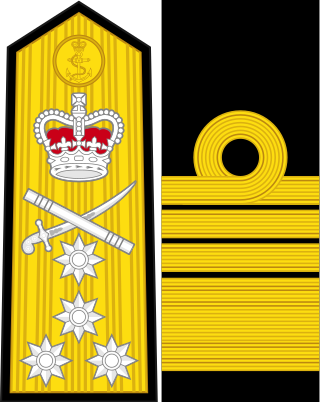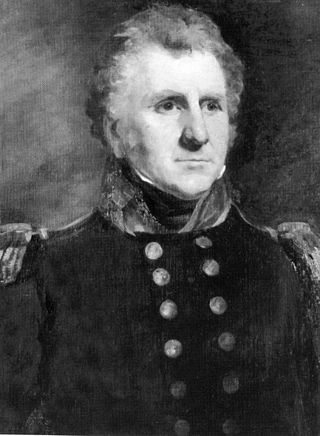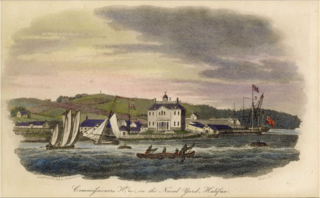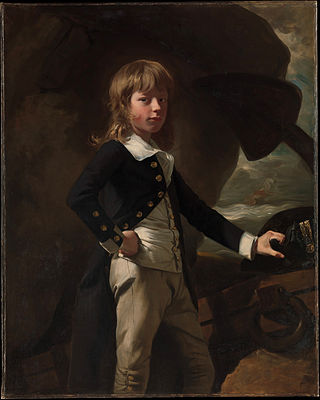
Greenwich Hospital was a permanent home for retired sailors of the Royal Navy, which operated from 1692 to 1869. Its buildings, in Greenwich, London, were later used by the Royal Naval College, Greenwich and the University of Greenwich, and are now known as the Old Royal Naval College. The word "hospital" was used in its original sense of a place providing hospitality for those in need of it, and did not refer to medical care, although the buildings included an infirmary which, after Greenwich Hospital closed, operated as Dreadnought Seaman's Hospital until 1986.

Sir James Lucas Yeo,, was a British naval commander who served in the War of 1812. Born in Southampton, he joined the Royal Navy at the age of 10 and saw his first action in the Adriatic Sea. He distinguished himself in combat multiple times, most notably during the Portuguese conquest of French Guiana, earning knighthoods in the Portuguese Order of Aviz and the British Order of the Bath. He was given command of the frigate Southampton, in 1812, but his ship was wrecked in the Bahamas although he was acquitted of blame for its loss. Yeo was then given command of the squadron on Lake Ontario and commanded it during several engagements with the Americans.

Rear-Admiral Sir Robert Barrie was a British naval officer noted for his service in the War of 1812. He was helped early in his naval career by the patronage of his uncle, Sir Alan Gardner, who arranged for him to take part in the Vancouver Expedition. When the Pacific Coast was explored, he had served as a midshipman with Captain Vancouver in 1791.

Admiral is a senior rank of the Royal Navy, which equates to the NATO rank code OF-9, outranked only by the rank of admiral of the fleet. Royal Navy officers holding the ranks of rear admiral, vice admiral and admiral of the fleet are sometimes considered generically to be admirals. The rank of admiral is currently the highest rank to which a serving officer in the Royal Navy can be promoted, admiral of the fleet being in abeyance except for honorary promotions of retired officers and members of the Royal Family.
Vice Admiral Francis Pickmore RN was a naval officer and colonial governor.

The Royal Naval College, Osborne, was a training college for Royal Navy officer cadets on the Osborne House estate, Isle of Wight, established in 1903 and closed in 1921.

Admiral Sir Charles Adam was a Scottish Royal Navy officer and politician who served during the Napoleonic Wars. He later commanded the royal yacht, Royal Sovereign, and was the Member of Parliament for Clackmannanshire and Kinross-shire. He held the office of First Naval Lord three times. In that capacity he dealt ably with the economies of a peacetime budget, provided naval support for the expulsion of Muhammad Ali's forces from Syria in 1840 and ensured technological progress continued. He was also the father of William Patrick Adam, a colonial administrator and Liberal politician.

Royal Naval Dockyard, Halifax was a Royal Navy base in Halifax, Nova Scotia. Established in 1759, the Halifax Yard served as the headquarters for the Royal Navy's North American Station for sixty years, starting with the Seven Years' War. The Royal Navy continued to operate the station until it was closed in 1905. The station was sold to Canada in 1907 becoming His Majesty's Canadian Dockyard, a function it still serves today as part of CFB Halifax.

The Kingston Royal Naval Dockyard was a Royal Navy Dockyard from 1788 to 1853 in Kingston, Ontario, Canada, at the site of the current Royal Military College of Canada.
Vice-Admiral Hyde Parker CB, sometimes referred to as Hyde Parker III, was a Royal Navy officer. As a junior officer he took part in the capture of the Cape of Good Hope in January 1806 during the Napoleonic Wars. He also commanded the naval forces at the siege of Machias in September 1814 and took the surrender of the frigate USS President in January 1815 during the War of 1812. He became First Naval Lord in February 1852 and in that capacity he ensured that all new warships being procured were propelled by steam and he also increased the size of the active fleet.

Admiral Sir Sydney Colpoys Dacres, was an officer of the Royal Navy who saw service during the Greek War of Independence, when he was involved in an attack on the Turkish forces at Morea, and later during the Crimean War. Born into a substantial naval dynasty during the Napoleonic Wars, he eventually rose to the rank of Admiral and became First Naval Lord. His only significant action as First Naval Lord was to press for the abolition of masts. He went on to be Visitor and Governor of Greenwich Hospital.

The Royal School, Haslemere is an independent day and boarding school established in 1995. The school is on two sites in Haslemere and Hindhead in Surrey, England. It has a foundation in Christianity. The Royal School was formerly a girls' only school. The school currently accepts students aged 4 to 18 years old.

A Royal Naval Hospital (RNH) was a hospital operated by the British Royal Navy for the care and treatment of sick and injured naval personnel. A network of these establishments were situated across the globe to suit British interests. They were part of the Royal Naval Medical Service. The British Army equivalent was a Military Hospital, and in the 20th century a number of RAF Hospitals were also established.

HMS Warspite was a 74-gun third-rate ship of the line of the Royal Navy, launched in 1807. She served in the Napoleonic Wars and was decommissioned in 1815. After conversion to a 76-gun ship in 1817 she circumnavigated the world, visiting Australia. She was cut down to a single decker 50-gun frigate in 1840 and was decommissioned in 1846. She was lent as a boys' training ship to The Marine Society and was lost to fire in 1876.

Admiral of the Fleet Sir Thomas Byam Martin, was a Royal Navy officer. As captain of fifth-rate HMS Fisgard he took part in a duel with the French ship Immortalité and captured her at the Battle of Tory Island during the French Revolutionary Wars. Then while in command of the third-rate HMS Implacable in the Baltic Sea and attached to the Swedish Navy he took part in the capture the Russian ship Sewolod (Vsevolod) during the Napoleonic Wars.

Augustus Brine was an officer of the Royal Navy who served during the American War of Independence and the French Revolutionary and Napoleonic Wars.
Eastman's Royal Naval Academy, originally in Southsea and later at Winchester, both in England, was a preparatory school. Between 1855 and 1923 it was known primarily as a school that prepared boys for entry to the Royal Navy. Thereafter, it was renamed Eastman's Preparatory School and continued until the 1940s. According to Jonathan Betts, it was "considered one of the top schools for boys intended for the Navy".

The Royal Naval College, Greenwich, was a Royal Navy training establishment between 1873 and 1998, providing courses for naval officers. It was the home of the Royal Navy's staff college, which provided advanced training for officers. The equivalent in the British Army was the Staff College, Camberley, and the equivalent in the Royal Air Force was the RAF Staff College, Bracknell.
The Flag Officer Commanding, North Atlantic was an operational commander of the Royal Navy between 1939 and 1943. His subordinate units, establishments, and staff were charged with the administration of the RN Naval Base, Gibraltar and North Atlantic geographic area. The admiral commanding's post later became the Flag Officer Gibraltar.
Vice-Admiral Sir Robert Lewis Fitzgerald was a British naval officer of the 18th and 19th centuries. He served throughout the French Revolutionary Wars, most notably commanding the bomb vessel HMS Vesuvius, but illness made him unable to go to sea during the Napoleonic Wars, with Fitzgerald instead commanding the Isle of Wight sea fencibles. Made a superannuated rear-admiral in 1825, he was restored as a vice-admiral in 1840.
















